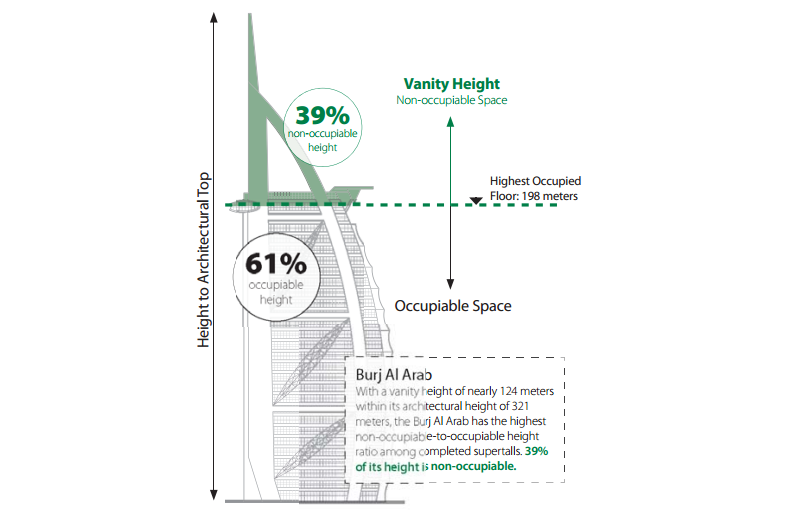The title for the world's tallest skyscraper is basically a pissing contest between international developers, and as the Skyscraper Index proposes, building height is tied to booms and busts. But building skyscrapers cost money and requires great deal of engineering expertise.
A simple but deceptive way to increase the height of a building is to put a spire on top. Adding pinnacles to skyscrapers allow developers to add meters to the building without adding significant cost, as well as avoiding increase in engineering complexities. Building a spire, after all, is cheaper than building habitable space. The added portion remains unoccupied (and is often incapable of) but still counts when the height of the building is measured.
The Council on Tall Buildings and Urban Habitat, a not-for-profit organization that tracks the world's skyscrapers, has released some data on the subject. CTBUH found that nearly 60 percent of the world's supertalls wouldn't actually be supertalls at all without the added wasteful space that the organization calls “vanity height”.
The Burj Khalifa, the tallest building in the world at nearly 830 meters, has 244 meters of unoccupied space. To put that in context, if that 244 meters were itself a building, it would be the 11th tallest in Europe. The worst offender of all is the Burj Al Arab, also in the U.A.E., of which 39 percent is vanity spire. This is followed by two more skyscrapers again from U.A.E. - Emirates Tower One and Emirates Tower Two with respectively, 32% and 31% of unoccupied height. Apparently, U.A.E leads the pack, but China and the US are close on heels.
The trend is not necessarily a new one - the Chrysler Building and the Empire State Building of New York City are two of the earliest examples of this growing phenomenon. The practice started in the 1930s, but remained dormant for half a century, before making a brief appearance during the mid-1970s, then really hit the roof after 2000. According to the findings of CTBUH, out of the 74 completed supertalls with vanity heights, as many as 65 were constructed after 1990. Buildings constructed after 1999 have an average vanity height of 16%.
You can read the full report from CTBUH here.

via PopSci














I am sorry, this graph makes no sense...
ReplyDeletethe highest occupable space belongs to Burj Al Arab? so, that's the "zero line", but according to the drawings of the three buildings left to it... it doesn't seem that above that height on these, it would be un-occupable spaces...
Sorry, man... the effort is excellent, and I am possibly misreading the thing altogether, but in my humble opinion, this graph is a little strange.
The graph sets each of the buildings non occupable level at the zero mark, then the height above the mark is what is taken in consideration. The height of the building below the 0 mark is irrelevant.
DeleteYou obviously don't comprehend the graph.
DeleteIt makes total sense.
The highest occupied floor becomes "zero", everything measured above that point becomes the % of "vanity height measured against the building's total height.